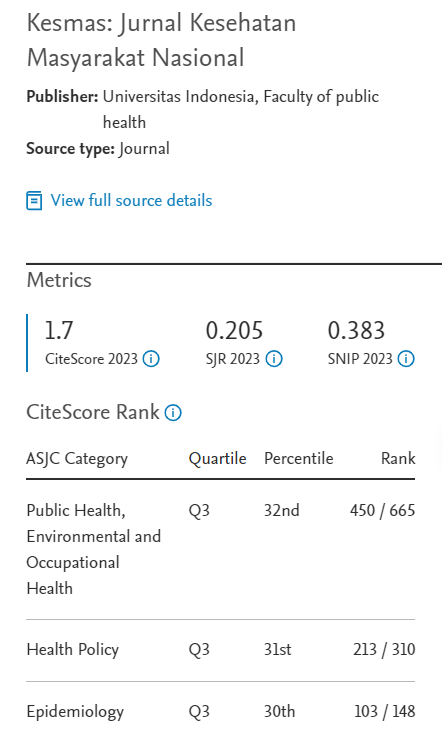Abstract
Excessive use of social media can lead to vulnerability to social media disorder, which is significantly related to the trend of mental health problems among college students. This study aimed to assess the prevalence of social media disorder among college students and to determine the relationship between the number of social media accounts, the total duration of social media use, and social media disorder. This cross-sectional study collected data through an online survey of 201 college students from the class of 2021 in the Faculty of Public Health, Universitas Indonesia. This study used the Social Media Disorder scaleand univariate and bivariate analysis to analyze the data. The prevalence of social media disorder was 23.9%; 93% of students were classified as high-duration social media users, and 58.2% had more than 10 accounts. Statistically, there was a significant relationship between the number of accounts (p-value= 0.045) and social media disorder. However, there was no significant relationship between the duration of social media use and social media disorder (p-value = 0.560). As a suggestion, the self-regulation factor must be considered an independent variable in predicting social media disorder among college students.
References
1. Kemp S. Digital 2021: Indonesia. We Are Social & Meltwater; 2021.
2. GlobalWebIndex. Social: GlobalWebIndex’s flagship report on the latest trends in social media, Flagship Report 2020. London: GlobalWebIndex; 2020.
3. Ataee M, Ahmadi Jouybari T, Emdadi SH, et al. Prevalence of internet addiction and its associated factors in Hamadan University of Medical College students. Life Sci J. 2014; 11 (4s): 214–217.
4. Scott H, Cleland Woods H. Fear of missing out and sleep: Cognitive behavioural factors in adolescents’ nighttime social media use. J Adolesc. 2018; 68: 61–65. DOI: 10.1016/j.adolescence.2018.07.009
5. Levenson JC, Shensa A, Sidani JE, et al. Social Media Use Before Bed and Sleep Disturbance Among Young Adults in the United States: A Nationally Representative Study. Sleep. 2017; 40 (9): zsx113. DOI: 10.1093/sleep/zsx113
6. Zhang D, Feng X, Chen P. Examining microbloggers’ individual differences in motivation for social media use. Soc Behav Pers. 2018; 46 (4): 667–682. DOI: 10.2224/sbp.6539
7. Ward K. The impact of social media use on adolescent mental health and social participation. Alhambra, CA: California School of Professional Psychology, Alliant International University; 2017.
8. Sherman LE, Payton AA, Hernandez LM, et al. The Power of the Like in Adolescence: Effects of Peer Influence on Neural and Behavioral Responses to Social Media. Psychol Sci. 2016; 27 (7): 1027-1035. DOI: 10.1177/0956797616645673
9. Ryan T, Allen KA, Gray DLL, et al. How social are social media? A review of online social behaviour and connectedness. J Relationships Res. 2017; 8: e8. DOI: 10.1017/jrr.2017.13
10. van den Eijnden RJJM, Lemmens JS, Valkenburg PM. The social media disorder scale. Comput Human Behav. 2016; 61: 478–487. DOI: 10.1016/j.chb.2016.03.038
11. Karimi L, Khodabandelou R, Ehsani M, et al. Applying the uses and gratifications theory to compare higher education students’ motivation for using social networking sites: Experiences from Iran, Malaysia, United Kingdom, and South Africa. Contemp Educ Technol. 2014; 5 (1): 53–72. DOI: 10.30935/cedtech/6115
12. Alexander LK, Lopes B, Ricchetti-Masterson K, et al. ERIC notebook. 2nd ed. Chapel Hill, NC: UNC Gillings School of Public Health; 2015.
13. Lemeshow S, Hosmer DW, Klar J, et al. Adequacy of sample size in health studies. Chichester: John Wiley & Sons; 1990.
14. Dewi SY, Lestari YM. Validity and reliability of Indonesian social media disorder (SMD) scale in adolescent. J Profesi Med J Kedokt Kesehat. 2020; 14 (2): 137–142. DOI: 10.33533/jpm.v14i2.2049
15. Zainita UH, Anshari D, Amelia T. Faktor-Faktor yang Berhubungan dengan Gangguan Media Sosial dan Fear of Missing Out (FoMO) pada Mahasiswa Program Sarjana Fakultas Kesehatan Masyarakat Universitas Indonesia [Undergraduate Thesis]. Depok: Universitas Indonesia; 2021.
16. Balqis SJ, Halimah L. Pengaruh self-regulation terhadap adiksi media sosial Instagram pada emerging adulthood. Pros Psikol. 2021; 7 (2): 202–2077. DOI: 10.29313/.v0i0.28273
17. Bloemen N, De Coninck D. Social media and fear of missing out in adolescents: The role of family characteristics. Soc Media Soc. 2020; 6 (4). DOI: 10.1177/2056305120965517
18. Kurniasanti SK, Assandi P, Ismail RI, et al. Internet addiction: A new addiction? Med J Indonesia. 2019; 28 (1): 82–91. DOI: 10.13181/mji.v28i1.2752
19. Boer M, Stevens GWJM, Finkenauer C, et al. Social media use intensity, social media use problems, and mental health among adolescents: Investigating directionality and mediating processes. Comput Human Behav. 2021; 116: 106645. DOI: 10.1016/j.chb.2020.106645
20. Coyne SM, Rogers AA, Zurcher JD, et al. Does time spent using socia lmedia impact mental health?: An eight year longitudinal study. Comput Human Behav. 2020; 104: 106160. DOI: 10.1016/j.chb.2019.106160
21. Merriam-Webster. Alter ego. Merriam-Webster Dictionary.
22. Barry CT, Sidoti CL, Briggs SM, et al. Adolescent social media use and mental health from adolescent and parent perspectives. J Adolesc. 2017; 61: 1–11. DOI: 10.1016/j.adolescence.2017.08.005
23. Glazzard J, Stones S. Social media and young people’s mental health. In: Selected Topics in Child and Adolescent Mental Health. 4th ed. IntechOpen; 2020. DOI: 10.5772/intechopen.77757
24. Yue Z, Zhang R, Xiao J. Passive social media use and psychological well-being during the COVID-19 pandemic: The role of social comparison and emotion regulation. Comput Human Behav. 2022; 127: 107050. DOI: 10.1016/j.chb.2021.107050
Recommended Citation
Amelia T , Zainita UH , Martha E ,
et al.
Social Media Use Behavior and Social Media Disorder Among Faculty of Public Health Students During the COVID-19 Pandemic.
Kesmas.
2023;
18(4):
265-270
DOI: 10.21109/kesmas.v18i4.6920
Available at:
https://scholarhub.ui.ac.id/kesmas/vol18/iss4/8







